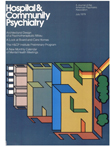The Architectural Design of a Psychotherapeutic Milieu
Abstract
The physical environment of a treatment program affects patient outcome, but how and to what degree is not known. However, decisions about the design of the environment must be made, and they must be made in the face of cost and building-code constraints and widely varying patient characteristics and treatment models. The authors describe the design principles and philosophies they followed in the remodeling of an inpatient treatment and research service in a university psychiatric hospital and indicate where cost and code constraints resulted in a less than ideal solution. They point out that many apparent amenities, such as a ward kitchen, are significant milieu therapy resources, and they advocate the involvement of all levels of staff in the planning process.
Access content
To read the fulltext, please use one of the options below to sign in or purchase access.- Personal login
- Institutional Login
- Sign in via OpenAthens
- Register for access
-
Please login/register if you wish to pair your device and check access availability.
Not a subscriber?
PsychiatryOnline subscription options offer access to the DSM-5 library, books, journals, CME, and patient resources. This all-in-one virtual library provides psychiatrists and mental health professionals with key resources for diagnosis, treatment, research, and professional development.
Need more help? PsychiatryOnline Customer Service may be reached by emailing [email protected] or by calling 800-368-5777 (in the U.S.) or 703-907-7322 (outside the U.S.).



